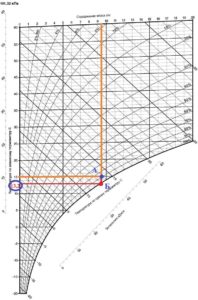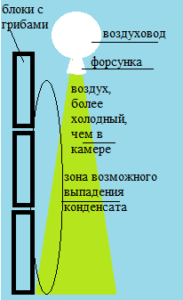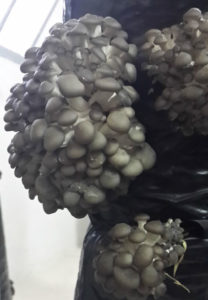Microclimate in oyster growing chamber.Mollier diagram and dew point.
Microclimate in oyster growing chamber.
Mollier diagram and dew point.
For many mushroom growers the expressions like “dew point” and “catch the dew on the pins” are quite familiar.
Let’s look at the nature of this phenomenon and measures to avoid it.
From school physics course and own experience most people know that when it becomes quite cold outside, the formation of fog is quite common. And when it comes to the condensate, most imagine this phenomenon as follows: once the dew point is reached, then primordia will be drained with water from condensation or there will be some visible droplets on the growing mushrooms (droplet is associated with the word “dew”). However, in most cases, the condensate is formed as a thin, almost invisible water layer, which evaporates very quickly cannot be sensed by touch. Therefore, many wonder: what is the danger of this phenomenon, if it cannot be even seen?
There are two dangers:
- Since it is almost invisible, it is impossible to estimate how many times per day growing primordia become covered with such a film, and how much damage it has caused them.
It is because of this “stealth” many pickers do not think of the condensation importance and do not understand the importance of its consequences for mushrooms, and their overall yield.
- Water film that completely covers the surface of primordia and young mushrooms, does not let moisture that accumulates in the cells of the surface layer to evaporate from the mushroom cap. Condensation occurs because of the temperature fluctuations in the growing chamber (see the details – below). When the temperature equalizes, thin condensate layer evaporates and only then begins the moisture evaporation from the fruit body itself. If the water in the mushroom cells stay for too long, cells begin to die. Long term (or short-term, but periodic) exposure to a water film inhibits evaporation of moisture to such an extent that primordia and the young mushroom up to 1 cm in diameter die.
When the pins become yellow, soft as a cotton wool, they release liquid when pressed, and the growers usually blame “bacterial infection” or “bad mycelium” for this. But, as a rule, such a death is associated with the development of secondary infections (bacterial or fungal) developing on the mushrooms and primordia, which die from the condensation effects.
So where does condensate arise from and what should be the temperature fluctuations to cause a dew point?
Mollier chart

To answer this question we should look at the Mollier diagram or enthalpy-entropy chart. It was invented to solve problems graphically, instead of cumbersome formulas.
Here we are going to study the simplest case.
Imagine the humidity in the chamber remains constant, but for whatever reason the temperature begins to drop (e.g., water enters the heat exchanger at a temperature lower than usual).
Let’s assume the air temperature in the chamber is 15 degrees and humidity is 89%. On Mollier diagram this corresponds to a blue point A, to which an orange line leads starting from 15. If this line continues upward, we see that the moisture content in this case will be 9.5 grams of water vapor in 1 m³ of air.
We have assumed that the moisture content does not change, i.e., the amount of water in the air has not changed, then when the temperature drops by only one degree, the humidity will be already 95%, and at the temperature of 13.5 it will amount to 98%.
If you continue the line down from point A (red), then at the intersection with the humidity curve at 100%, we get the point B (this is the dew point). Drawing a horizontal line to the temperature axis will see that the condensation will start at a temperature of 13.2 degrees.
What does this example give us?
We see that the temperature decrease by only 1.8 degrees in the area of new mushroom cluster formation can cause condensation. Dew will appear exactly on the pins, as they always have a temperature of 1° C lower than the chamber temperature due to constant evaporation from the cap surface.
Of course, in real life, if the air exits from the duct two degrees lower, it mixes with the warmer air of the chamber and the humidity does not increase up to 100%, but in the range of 95 – 98%.
However, it should be noted that in addition to temperature fluctuations in a real cultivation chamber, we have more humidification nozzles, which supply moisture in excess, because of that the moisture content also changes.

As a result, cold air may be oversaturated with water vapor, and mixing at the duct outlet could cause fog formation. Since an ideal air distribution is impossible to reach, any displacement of the flow may lead to the dew zone formation near the growing primordia, and could potentially kill them. At the same time, primordium growing close can be not affected by this zone, and the condensation will not harm it.
The sad thing is that, as a rule, the sensors are installed only on the chamber itself, and not in the air ducts. Therefore, most mushroom growers do not even notice any fluctuations of microclimate parameters in their chamber.
The cold air exiting from the air duct is mixed with a large volume of air in the room, and the air reaches the sensor with pretty “average values” in the chamber, and for fungi the comfortable climate is important exactly in their growth zone!
From all this, the following important conclusions could be made:
- Even the minor temperature fluctuations of 1.5 or 2 degrees may cause condensation and fungi spoilage.
- If you cannot avoid climate fluctuations, you simply have to lower the moisture content to the lowest possible value (at a temperature of 15 degrees the humidity should be at least 80-83%), then full water saturation of air is less likely.
 If a majority of primordia in the chamber have already passed phlox* stage and have a size of 1-1.5 cm, the risk of death from condensate decreases due to the cap growth and, accordingly, the growth of evaporation surface.
If a majority of primordia in the chamber have already passed phlox* stage and have a size of 1-1.5 cm, the risk of death from condensate decreases due to the cap growth and, accordingly, the growth of evaporation surface.
Then the humidity can be raised back to optimal level (87-89%) so that fungi could become more dense and heavy.
But you should do it gradually, no more than 2% a day – because the sharp humidity increase can lead again to moisture condensation on mushrooms.
* The phlox stage (see. photo) is the stage of primordia development, when they already split into separate tiny mushrooms, but they still remain ball-shaped. It looks like a phlox flower, hence a name.
- The humidity and temperature sensors are obligatory, not only in the oyster mushroom growing room, but also in the zone of primordial growth and in the air ducts. This is crucial to detect the temperature and humidity fluctuations.
- The automation helps to avoid both temperature and humidity fluctuations and fungi death caused by it. A program monitoring and coordinating the influence of climate parameters must be written specifically for the oyster mushroom growing chambers.
